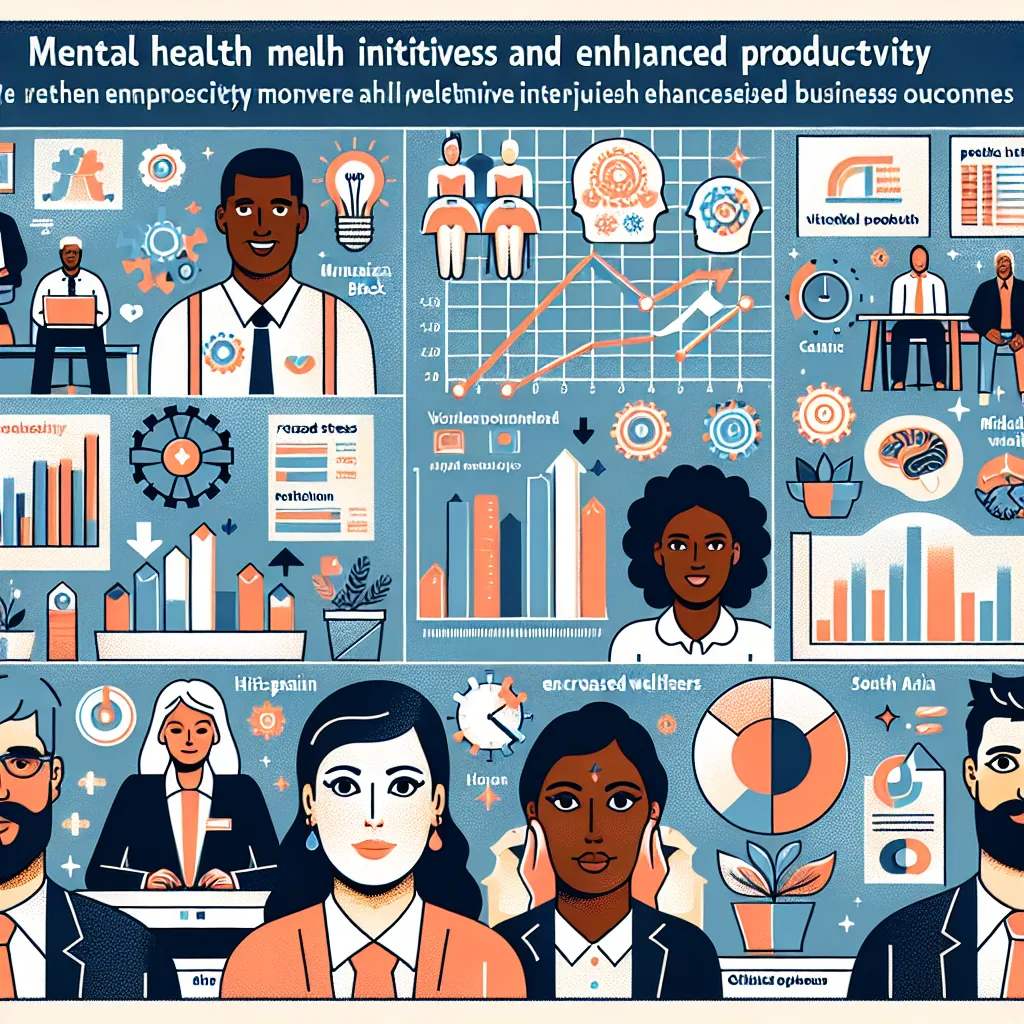In today’s IELTS Reading practice, we’ll explore a crucial topic that impacts both individuals and organizations: “The role of mental health programs in increasing productivity.” This subject is increasingly relevant in our modern work environment, where mental well-being is recognized as a key factor in overall productivity and success.
 Mental health and productivity correlation
Mental health and productivity correlation
Let’s dive into our IELTS Reading test, which consists of three passages of increasing difficulty. Remember to manage your time wisely, allocate about 20 minutes for each passage, and pay close attention to the instructions for each question type.
Passage 1 (Easy Text)
The Importance of Workplace Mental Health Programs
Mental health programs in the workplace have gained significant attention in recent years. Companies are increasingly recognizing the profound impact that employee mental well-being has on overall productivity and organizational success. These programs aim to create a supportive environment that promotes mental health awareness, reduces stigma, and provides resources for employees facing mental health challenges.
One of the primary benefits of implementing mental health programs is the reduction of absenteeism and presenteeism. Absenteeism refers to employees missing work due to mental health issues, while presenteeism occurs when employees are physically present but not fully productive due to mental health concerns. By addressing these issues through comprehensive programs, companies can significantly improve attendance rates and ensure that employees are more engaged and productive when they are at work.
Moreover, mental health programs can enhance employee retention and job satisfaction. When workers feel supported and valued, they are more likely to remain loyal to their employers and perform at their best. This, in turn, leads to reduced turnover rates and associated costs for recruitment and training.
Another crucial aspect of workplace mental health programs is their role in fostering a positive company culture. By openly addressing mental health, organizations demonstrate their commitment to employee well-being, which can improve morale and create a more inclusive work environment. This positive atmosphere often translates into increased collaboration, creativity, and overall productivity.
It’s important to note that effective mental health programs are not one-size-fits-all solutions. They should be tailored to the specific needs of the workforce and may include a variety of components such as counseling services, stress management workshops, mindfulness training, and flexible work arrangements. By offering a range of resources and support, companies can ensure that they are addressing the diverse mental health needs of their employees.
In conclusion, the implementation of mental health programs in the workplace is a strategic investment that can yield significant returns in terms of increased productivity, improved employee satisfaction, and enhanced organizational performance. As more companies recognize the importance of mental health in the workplace, these programs are likely to become an integral part of corporate wellness strategies in the future.
Questions 1-7
Do the following statements agree with the information given in the reading passage?
Write
TRUE if the statement agrees with the information
FALSE if the statement contradicts the information
NOT GIVEN if there is no information on this
- Mental health programs in the workplace have become more important in recent years.
- Absenteeism and presenteeism have the same impact on workplace productivity.
- Employees with good mental health are more likely to stay with their current employer.
- Mental health programs always lead to increased profits for companies.
- A positive company culture can result from addressing mental health openly.
- Effective mental health programs should be the same for all companies.
- Mental health programs are expected to become more common in corporate wellness strategies.
Questions 8-13
Complete the sentences below.
Choose NO MORE THAN TWO WORDS from the passage for each answer.
- Mental health programs aim to create a ____ environment in the workplace.
- ____ occurs when employees are present at work but not fully productive due to mental health issues.
- By implementing mental health programs, companies can improve ____ rates.
- Mental health programs can lead to reduced ____ rates and associated costs.
- A positive work atmosphere can increase ____ and creativity among employees.
- Companies should offer a range of ____ to address diverse mental health needs.
Passage 2 (Medium Text)
The Impact of Mental Health Programs on Organizational Productivity
The relationship between mental health and workplace productivity has been a subject of increasing interest among researchers and business leaders alike. As organizations strive to maximize efficiency and output, they are discovering that the mental well-being of their workforce plays a pivotal role in achieving these goals. This realization has led to a surge in the implementation of mental health programs across various industries, with compelling results that underscore their significance in boosting overall productivity.
One of the most salient benefits of mental health programs is their ability to reduce the economic burden of mental health issues on businesses. Studies have shown that mental health problems, such as depression and anxiety, can lead to substantial productivity losses. For instance, a report by the World Health Organization estimated that depression and anxiety disorders cost the global economy US$ 1 trillion each year in lost productivity. By investing in mental health initiatives, companies can mitigate these losses and potentially save millions in productivity costs.
Moreover, mental health programs contribute to the creation of a more resilient workforce. Employees who have access to mental health resources are better equipped to handle stress, adapt to change, and maintain high performance levels even in challenging circumstances. This resilience is particularly valuable in today’s fast-paced and often unpredictable business environment, where the ability to bounce back from setbacks is crucial for sustained productivity.
Another significant aspect of mental health programs is their role in fostering innovation and creativity. When employees feel mentally healthy and supported, they are more likely to engage in creative problem-solving and generate innovative ideas. This is because mental well-being is closely linked to cognitive function, including the ability to think flexibly and see connections between disparate concepts. By promoting mental health, organizations can tap into the full creative potential of their workforce, leading to breakthroughs and advancements that drive productivity and competitiveness.
Furthermore, mental health programs can enhance team dynamics and collaboration. When individuals are mentally healthy, they are better able to communicate effectively, empathize with colleagues, and work cooperatively towards common goals. This improved interpersonal functioning can lead to more efficient teamwork, smoother project execution, and ultimately, higher productivity levels across the organization.
It’s worth noting that the effectiveness of mental health programs in increasing productivity is not limited to large corporations. Small and medium-sized enterprises (SMEs) can also reap significant benefits from implementing such initiatives. In fact, due to their more intimate work environments, SMEs may find it easier to create a culture of openness around mental health and to tailor programs to the specific needs of their employees.
However, to maximize the impact of mental health programs on productivity, organizations must approach their implementation strategically. This involves conducting thorough needs assessments, ensuring leadership buy-in, providing ongoing education and training, and regularly evaluating the effectiveness of the programs. Additionally, it’s crucial to integrate mental health initiatives into the broader organizational culture and policies, rather than treating them as isolated efforts.
In conclusion, the role of mental health programs in increasing productivity is multifaceted and profound. By reducing the economic burden of mental health issues, fostering resilience, promoting innovation, enhancing team dynamics, and benefiting organizations of all sizes, these programs have become indispensable tools for businesses seeking to thrive in the modern economy. As awareness of the link between mental health and productivity continues to grow, it is likely that we will see even more sophisticated and effective mental health initiatives emerging in workplaces around the world.
Questions 14-19
Choose the correct letter, A, B, C, or D.
-
According to the passage, mental health programs in the workplace:
A) Are only effective in large corporations
B) Have become more popular due to their impact on productivity
C) Are mainly focused on treating depression and anxiety
D) Always lead to immediate increases in company profits -
The World Health Organization report mentioned in the passage states that:
A) All companies should implement mental health programs
B) Mental health issues cost the global economy $1 trillion annually
C) Depression is more costly than anxiety for businesses
D) Productivity losses are inevitable in any business -
Resilience in the workforce is described as:
A) The ability to work long hours without breaks
B) A characteristic only found in senior management
C) The capacity to adapt and perform well in challenging situations
D) A trait that cannot be improved through mental health programs -
According to the passage, mental well-being is linked to:
A) Higher salaries for employees
B) Increased cognitive function and creativity
C) Reduced need for teamwork
D) Lower employee turnover rates -
The passage suggests that small and medium-sized enterprises (SMEs):
A) Cannot afford to implement mental health programs
B) Do not benefit from mental health initiatives
C) May find it easier to create an open culture around mental health
D) Should focus on productivity rather than mental health -
To maximize the impact of mental health programs, the passage recommends:
A) Implementing them as isolated efforts
B) Focusing solely on leadership training
C) Ignoring the needs of individual employees
D) Integrating them into the broader organizational culture
Questions 20-26
Complete the summary below.
Choose NO MORE THAN TWO WORDS from the passage for each answer.
Mental health programs play a crucial role in increasing workplace productivity. These programs help reduce the 20____ of mental health issues on businesses. Employees with access to mental health resources develop greater 21____, which is valuable in today’s unpredictable business environment. Mental well-being is also linked to increased 22____ and creativity, allowing organizations to tap into the full potential of their workforce. Moreover, these programs can improve 23____ and collaboration among team members. The benefits of mental health initiatives are not limited to large companies; 24____ can also see significant improvements. To be most effective, mental health programs should be implemented 25____ and integrated into the broader 26____ of the organization.
Passage 3 (Hard Text)
The Multifaceted Role of Mental Health Programs in Enhancing Workplace Productivity
The intricate relationship between mental health and workplace productivity has become a focal point of organizational psychology and management studies in recent years. As businesses grapple with the complexities of the modern work environment, there is a growing recognition of the pivotal role that mental health programs play in not only supporting employee well-being but also in driving substantial gains in productivity and overall organizational performance.
At the core of this paradigm shift is the understanding that mental health is not merely the absence of mental illness, but rather a state of psychological and emotional well-being that enables individuals to realize their potential, cope with the normal stresses of life, work productively, and contribute meaningfully to their communities. This holistic view of mental health has led to the development of comprehensive workplace programs that go beyond traditional employee assistance programs (EAPs) to encompass a wide range of interventions and support mechanisms.
One of the most significant ways in which mental health programs contribute to increased productivity is through the mitigation of presenteeism. Unlike absenteeism, which is readily observable and quantifiable, presenteeism—the practice of employees coming to work despite illness, injury, or other distress, often resulting in reduced productivity—presents a more insidious challenge to organizational efficiency. Studies have shown that the costs associated with presenteeism due to mental health issues can be up to seven times higher than those related to absenteeism. By providing accessible mental health resources and fostering a culture that encourages seeking help, organizations can significantly reduce the hidden productivity losses associated with presenteeism.
Moreover, well-designed mental health programs can serve as powerful catalysts for enhancing cognitive function and creative problem-solving abilities among employees. Research in neuroscience has demonstrated that chronic stress and poor mental health can impair executive functions such as attention, memory, and decision-making. Conversely, interventions that promote mental well-being, such as mindfulness training and cognitive behavioral therapy, have been shown to improve these cognitive capabilities. This enhancement of cognitive function can lead to more innovative solutions, better strategic thinking, and ultimately, increased organizational productivity.
Another critical aspect of mental health programs in the context of productivity is their role in fostering psychological safety within teams. Psychological safety, defined as the shared belief that the team is safe for interpersonal risk-taking, has been identified as a key predictor of team performance. Mental health initiatives that promote open communication, reduce stigma, and encourage vulnerability can significantly contribute to creating psychologically safe environments. In such settings, employees are more likely to voice ideas, provide constructive feedback, and engage in the kind of collaborative problem-solving that drives innovation and productivity.
Furthermore, the implementation of comprehensive mental health programs can lead to a virtuous cycle of improved organizational culture and increased productivity. As employees experience the benefits of these programs, they develop greater trust in their employers and a stronger sense of organizational commitment. This enhanced engagement can manifest in various ways that boost productivity, including increased discretionary effort, higher levels of customer service, and greater willingness to go above and beyond job requirements.
It is important to note, however, that the effectiveness of mental health programs in increasing productivity is contingent upon their strategic design and implementation. A one-size-fits-all approach is unlikely to yield optimal results. Instead, organizations must tailor their programs to the specific needs of their workforce, taking into account factors such as industry-specific stressors, demographic composition, and cultural nuances. Additionally, the success of these programs hinges on strong leadership support, clear communication of available resources, and ongoing evaluation and refinement based on employee feedback and measurable outcomes.
The role of technology in mental health programs also warrants consideration. Digital platforms and mobile applications have expanded the reach and accessibility of mental health support, allowing employees to access resources anytime and anywhere. However, the integration of technology must be balanced with privacy concerns and the need for human connection. Blended approaches that combine digital tools with in-person support may offer the most comprehensive and effective solutions for enhancing mental health and, by extension, productivity.
In conclusion, the role of mental health programs in increasing workplace productivity is multifaceted and profound. By addressing presenteeism, enhancing cognitive function, fostering psychological safety, improving organizational culture, and leveraging technology, these programs have the potential to drive significant improvements in individual and collective performance. As the global business landscape continues to evolve, organizations that prioritize and invest in the mental health of their workforce are likely to gain a substantial competitive advantage, reaping the benefits of a more engaged, resilient, and productive workforce.
Questions 27-31
Choose the correct letter, A, B, C, or D.
-
According to the passage, the modern understanding of mental health in the workplace:
A) Focuses solely on treating mental illnesses
B) Is limited to traditional employee assistance programs
C) Encompasses a holistic view of psychological and emotional well-being
D) Is primarily concerned with reducing absenteeism -
The passage suggests that presenteeism:
A) Is easier to measure than absenteeism
B) Costs less than absenteeism
C) Is a more visible problem than absenteeism
D) Can be more costly than absenteeism -
Research in neuroscience has shown that:
A) Stress always improves cognitive function
B) Mental health has no impact on decision-making abilities
C) Poor mental health can impair executive functions
D) Mindfulness training reduces creativity -
Psychological safety in teams is described as:
A) A barrier to interpersonal risk-taking
B) Unrelated to team performance
C) A key factor in promoting team performance
D) Something that discourages open communication -
The passage suggests that the effectiveness of mental health programs:
A) Is guaranteed regardless of implementation strategy
B) Depends on a one-size-fits-all approach
C) Requires tailoring to specific workforce needs
D) Is independent of leadership support
Questions 32-37
Complete the sentences below.
Choose NO MORE THAN THREE WORDS from the passage for each answer.
- Mental health programs can create a ____ of improved organizational culture and increased productivity.
- The success of mental health programs depends on factors including strong leadership support and ____ of available resources.
- Digital platforms and mobile applications have increased the ____ of mental health support for employees.
- Organizations must balance the use of technology with ____ and the need for human connection.
- Mental health programs that are effectively implemented can give organizations a significant ____.
- Investing in mental health can lead to a more ____ workforce.
Questions 38-40
Do the following statements agree with the claims of the writer in the reading passage?
Write
YES if the statement agrees with the claims of the writer
NO if the statement contradicts the claims of the writer
NOT GIVEN if it is impossible to say what the writer thinks about this
- Mental health programs are only effective in large multinational corporations.
- The integration of technology in mental health programs is essential for their success.
- Organizations that prioritize mental health are likely to perform better than those that do not.
Answer Key
Passage 1
- TRUE
- NOT GIVEN
- TRUE
- NOT GIVEN
- TRUE
- FALSE
- TRUE
- supportive
- Presenteeism
- attendance
- turnover
- collaboration
- resources
Passage 2
- B
- B
- C
- B
- C
- D
- economic burden
- resilience
- innovation
- team dynamics
- SMEs
- strategically
- organizational culture
Passage 3
- C
- D
- C
- C
- C
- virtuous cycle
- clear communication
- reach and accessibility
- privacy concerns
- competitive advantage
- engaged, resilient, and productive
- NO
- NOT


